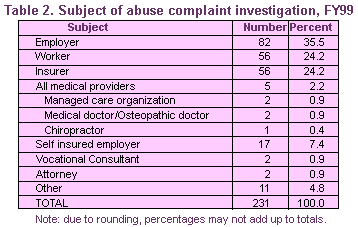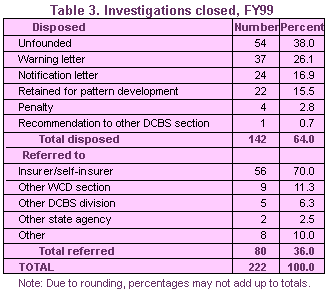
The Workers’ Compensation Division of the Department of Consumer and Business Services (DCBS) investigates allegations of statute or administrative rule violations in an effort to minimize abuse of the workers’ compensation system. The division investigates complaints involving abuse or fraud by medical providers, insurers, employers, and claimants. This report summarizes the division’s complaint investigation activity from July 1, 1998 through June 30, 1999 (FY99).
In FY99, 231 investigations into complaints of abuse or fraud were opened, averaging 19 a month. This is a 5.3 percent decrease from the 244 investigations opened in FY98. Until FY98 the number of investigations opened had been decreasing every year since FY 93, when a high of 342 investigations were opened. While FY99 is lower than FY98, it shows increased numbers of investigations opened since FY97.

The most frequent complaints received were for improper processing by the insurer or medical provider (66 or 29 percent of the total), employer pressure to not file a claim (48 or 21 percent of the total) and workers collecting workers’ compensation benefits when able to work (45 or 19 percent of the total). Other complaints included: failure or improper reporting of claims-related documents by either the employer, insurer, or medical provider (9 or 4 percent of the total), harassment (5 or 2 percent of the total), and improper billing (8 or 3 percent of the total). All other complaints accounted for 22 percent of the total investigations opened (including 13 cases reviewed six months after closure).

Twenty-four percent (56) of the 231 complaint investigations
opened in FY99 were against workers. Of these investigations,
80 percent (45) were for collecting workers’ compensation
benefits when able to work. Thirty-five percent (82) of the investigations
were against employers. This is an increase from FY98 where 29
percent (70) of the investigations opened were against employers.
Fifty-two percent (43) of the investigations against employers
were for employer pressure to not file a claim. Twenty-four percent
(56) of the investigations were against insurers; 63 percent
of those investigations were for improper claims processing.
All medical providers accounted for two percent (5) of the investigations
and self-insured employers accounted for seven percent (17) of
investigations opened.

In FY99, 222 investigations of abuse or fraud complaints were closed compared to 287 closures in FY98. An average of 19 complaint investigations were closed each month in FY99. These complaints were closed either by disposition (64 percent) or by referral (36 percent). Of the 142 disposed complaints, 54 (38 percent) were unfounded, 37 (26 percent) were given a letter of reprimand or warning, 24 (17 percent) were issued a letter of notification and 4 (3 percent) were given a penalty.

Thirty-six percent (80) of the investigations were closed
by referral. Seventy percent (56) of these referrals were made
to the insurer (or self-insurer). Complaints referred to the
insurer most often consisted of claimant fraud such as collecting
workers’ compensation benefits when able to work (78 percent).
Eleven percent (9) of the referrals were to another WCD section,
six percent (5) were made to another DCBS division and three
percent (2) were made to another state agency.
If you have questions about the information
contained in this document please contact by e-mail or phone:
Ed Bissell Research
Manager, Research & Analysis Section, Information Management
Division (503) 947-7364. This document was originally published
in July 2000. [Printed form: 440-2471(10/00/imd)]
In compliance with the Americans with Disabilities Act (ADA), this publication is available in alternative formats by calling (503) 378-4100 (V/TTY). The information in IMD publications is in the public domain and may be reprinted without permission.